Abstract
We present an interactive system that lets a user move and deform
a two-dimensional shape without manually establishing a skeleton
or freeform deformation (FFD) domain beforehand. The shape is
represented by a triangle mesh and the user moves several vertices
of the mesh as constrained handles. The system then computes the
positions of the remaining free vertices by minimizing the
distortion of each triangle. While physically based simulation or
iterative refinement can also be used for this purpose, they tend to
be slow. We present a two-step closed-form algorithm that
achieves real-time interaction. The first step finds an appropriate
rotation for each triangle and the second step adjusts its scale. The
key idea is to use quadratic error metrics so that each
minimization problem becomes a system of linear equations.
After solving the simultaneous equations at the beginning of
interaction, we can quickly find the positions of free vertices
during
interactive manipulation. Our approach successfully
conveys a sense of rigidity of the shape, which is difficult in
space-warp approaches. With a multiple-point input device, even
beginners can easily move, rotate, and deform shapes at will.
CR Categories: I.3.6 [Computer Graphics]: Methodology and
Techniques – Interaction Techniques; I.3.3 [Computer Graphics]:
Picture/Image Generation – Display algorithms; I.3.5 [Computer
Graphics]: Computational Geometry and Object Modeling –
Geometric algorithms.
Keywords: Shape Manipulation, Deformation, Image Editing,
Mesh Editing, Animation, Interaction
1 Introduction
With a 2D image or drawing at hand, a user might want to
manipulate it—move, rotate, stretch, and bend it. The primary
application we have in mind is an editing tool for drawing or
image-editing systems, but our interactive shape manipulation
technique is also useful in various applications such as real-time
live performance [Ngo et al. 2000] and enriching graphical user
interfaces [Bruce and Calder 1995].
One popular approach for shape manipulation is to use a pre-
defined skeleton. The user manipulates the skeleton configuration
and the system adjusts the overall shape relative to the skeleton.
However, defining a skeleton structure for a shape is not a trivial
task [Lewis et al. 2000] and is not effective for objects, such as
jellies, that lack an obvious jointed structure. Another popular
method is free-form deformation (FFD) [MacCracken and Joy
1996] in which the user explicitly divides the space into several
domains and manipulates each domain by moving control points
defining it. But setting FFD domains is tedious and the user must
laboriously manipulate many control vertices.
As-Rigid-As-Possible Shape Manipulation
Takeo Igarashi1, 3 Tomer Moscovich2 John F. Hughes2
1The University of Tokyo 2Brown University 3PRESTO, JST
This paper presents an interactive system that allows the user to
manipulate a shape without using a skeleton or FFD. The user
chooses several points inside the shape as handles and moves each
handle to a desired position. The system then moves, rotates, and
deforms the overall shape to match the given handle positions
while minimizing distortion. By taking the interior of the shape
into account, our approach can model its rigidity (i.e., internal
resistance to deformation), making the result much closer to the
behavior of real-world objects than in space-warp approaches as
in [Barrett and Cheney 2002; Llamas et al. 2003].
We use a two-step closed-form algorithm for finding the shape
configuration that minimizes distortion. The typical approach is to
use a physically based simulation or nonlinear optimizations
[Sheffer and Kraevoy 2004], but these techniques are too slow for
interactive manipulation. A key aspect of our approach is the
design of a quadratic error metric so that the minimization
problem is formulated as a set of simultaneous linear equations.
Our system solves the simultaneous equations at the beginning,
and can therefore quickly find a solution during interaction.
Ideally we would like a single quadratic error function that
handles all properties of a shape, but no such function exists (see
Appendix A). We therefore split the problem into a rotation part
and a scale part. This divides the problem into two least-squares
minimization problems that we can solve sequentially. This
method can be seen as a variant of the method proposed by
Sorkine et al. [2004].
Our technique can be useful in standard dragging operations with
a mouse, but it is particularly interesting when using a multiple-
point input device such as a SmartSkin touchpad [Rekimoto 2002]
(Figure 1). With such a device, one can interactively move, rotate,
and deform an entire shape as if manipulating a real object using
both hands. This is difficult with existing shape deformation tools
because most allow only local modification while the overall
position and orientation of the shape remain fixed.
Figure 1: Shape manipulation using a SmartSkin touchpad. The user can
interactively move, rotate, and deform the shape using both hands as if
manipulating a real object.
�
2 Related Work
Shape manipulation techniques fall roughly into two categories.
One is to deform the space in which the target shape is embedded;
the other is to deform the shape while taking its structure into
account.
Deformation using skeletons, FFD, and other space-warp
approaches belong to the first category. With skeletons, each point
in the shape is associated with a coordinate frame defined by a
bone [Lewis et al. 2000]. In FFD, each point is associated with a
closed region in a FFD grid [MacCracken and Joy 1996]. Other
space warp techniques deform the global space [Milliron et al.
2002]. Beier and Neely used space deformation for morphing
[1992]. Twister deforms the global space according to two 6-DOF
controls [Llamas et al. 2003], and Barrett and Cheney [2002] used
space-warp deformation for digital image editing. Brookstein
[1989] used thin-plate splines to find a space deformation that is
defined by several control points. A drawback of these approaches
is that they model the rigidity of the ambient space, rather than
that of the shape itself, and thus the resulting deformation differs
greatly from the behavior of real objects.
The second category includes physically based methods, the most
popular of which are mass-spring models [Gibson and Mirtich
1997]. These are very easy to implement, but their behavior is too
elastic for many applications and they often converge slowly. In
addition, careful parameter tuning is required to make them really
work. More physically accurate simulation is possible with finite-
element methods [Celniker and Gossard 1991], but these are very
complicated and expensive to solve, making them inappropriate
for interactive manipulation of simple drawings. The ArtDefo
system [James and Pai 1999] achieved physically accurate,
interactive shape deformation using boundary-elements, but it is
limited to very small deformations such as poking the surface and
is not applicable to large deformations like bending an arm.
The work presented here belongs to the second category. Our goal
is to introduce internal model rigidity into shape manipulation.
However, instead of using physically based models, we use
simple geometric approach similar to a technique used in [Alexa
et al. 2000]. They obtain an as-rigid-as-possible interpolation
between shapes by computing a rigid transformation for each
triangle element geometrically and stitching them together.
Similarly, we achieve as-rigid-as-possible manipulation by
geometrically minimizing the distortion associated with each
triangle in a mesh. Sheffer and Kraevoy [2004] introduce a similar
deformation tool, but use an iterative computation that is too
expensive for interactive manipulations, especially when the
control vertices move quickly.
The algorithm we use can be seen as a variant of the Laplacian
surface-editing method proposed by Sorkine et al. [2004]. They
achieved fast detail-preserving deformation by using rotation- and
scale-invariant Laplacian coordinates. They also proposed scaling
the Laplacians of the deformed shape back to their original scale
and re-solving. Similarly, we add a scale-preserving effect to the
initial deformation process. We show that this scale-preservation
effect makes possible more dynamic manipulation than is seen in
their paper’s examples, where the user fixes most of the shape and
moves only a specific region of interest.
image—into
3 Overview
We start with an overview of the system to establish a context for
the core algorithms described in the next section.
The user first imports a 2D shape—represented either by vector
graphics or a bitmap
the system. The only
requirement is that the boundary of the shape can be represented
as a simple closed polygon. For bitmap images, we currently
manually remove backgrounds and apply automatic silhouette
tracing using the marching squares algorithm. The system then
generates a triangulated mesh inside the boundary. Various
triangulation methods are available [Shewchuk 1996], but better
manipulation results are achieved by using near-equilateral
triangles of similar sizes across the region. We use a particle-
based algorithm to obtain such a mesh [Markosian 1999]. Starting
with a standard constrained Delaunay triangulation, the system
iteratively refines the mesh by adjusting vertex positions and
mesh connectivity. To work at interactive rates, it is important that
the mesh not be too large. Our current implementation generates
meshes with 100-300 vertices within a few seconds. The resulting
triangulation is registered as the “rest shape,” and the system
performs a pre-computation (which we call “registration”) to
accelerate the computation during the interaction (Figure 2a).
Original
drawing or image
Triangle
Mesh
Handles
Result
b) Compilation
c) Manipulation
a) Triangulation and registration
Figure 2: Overview of the system. The system first triangulates the
original shape, and performs some pre-computation. The user adds
handles. Moving the handles results in a fast deformation.
The user manipulates the shape by indicating handles on the shape
and then interactively moving the handles (Figure 2b,c). The user
clicks on the shape to place handles and drags the handles to move
them. We currently let the user place handles only at existing
mesh vertices. Ideally, the system would allow the user to put
handles at arbitrary locations and modify the mesh structure to
include the handle. We plan to incorporate such a re-meshing
mechanism into the system in the future.
Our system also supports multiple-point input devices. We
currently use SmartSkin [Rekimoto 2002], which can track
multiple fingers touching its surface. By projecting the drawing
onto the SmartSkin we bring the user's fingers into direct
correspondence with the constraint points (Figure 1). This lets the
user grasp and manipulate the drawing as if manipulating a real-
world object. We are also testing a Wacom tablet with two
orientation-sensitive mice. In this case, each mouse is associated
with a couple of vertices which are moved and rotated by the
mouse (Figure 16). The interface has some similarity to Twister
[Llamas et al. 2003], but the operation using our system is more
like manipulation of physical objects while their system is
designed for model construction.
Shape manipulation is first applied to the triangle mesh; the
system then maps the original drawing or image from the original
mesh to the deformed mesh. When manipulating vector graphics,
�
interaction,
we use the barycentric coordinates of each vertex within the
corresponding triangle of the mesh. When manipulating a bitmap
image, we simply use standard linear texture mapping.
The system performs additional pre-computations when new
handles are added or removed (Figure 2b). We call this process
“compilation” because this process actually prepares a function
that takes the handle configuration as input and returns the
resulting shape as output. During
the system
repeatedly sends the updated handle configuration to this function.
4. Algorithm
The input to the algorithm is the set of all xy-coordinates of the
constrained mesh vertices (Figure 3a) and the output is the xy-
coordinates of the remaining free vertices that minimize the
distortion associated with all triangles in the resulting mesh
(Figure 3d). The central challenge is to find an appropriate
definition for the distortion of an individual triangle. Our strategy
is to design an error metric that is quadratic in its free variables so
the system can solve the minimization problem as a simple matrix
computation.
Ideally we would like a single quadratic error function that
appropriately represents overall distortion. We have examined
various possibilities, but finally concluded that it is impossible to
design such a function (see Appendix A). Our solution is to split
the problem into a rotation part and a scale part so that each part is
handled by an independent quadratic error function. With this
decomposition, we can obtain the final result by sequentially
solving two least-squares problems.
Given the coordinates of the constrained vertices, the first step
generates an intermediate result by minimizing an error metric
that prevents shearing and non-uniform stretching but permits
rotation and uniform scaling (Figure 3a). The second step takes
this result and adjusts the scale of each triangle. This second step
is further decomposed into two sequential processes. The system
first fits each original triangle to the corresponding intermediate
triangles without changing scale (Figure 3b), and then computes
the final result by minimizing an error metric that represents the
difference between the fitted triangle and the resulting triangles
(Figure 3c). The following subsections describe each step in detail.
b
a
c
Figure 3: Overview of the algorithm. For the given handle configuration,
the system first generates an intermediate result by minimizing conformal
(i.e., scale-independent) distortion (a). The system then fits triangles from
the rest shape to corresponding triangles in the intermediate result (b). The
system generates a final result (c) by minimizing the difference between
the fitted triangles and the corresponding triangles.
4.1 Step one: scale-free construction
Step one generates an intermediate result by minimizing an error
function that allows rotation and uniform scaling. The input is the
xy-coordinates of the constrained vertices and the output is the xy-
coordinates of the remaining free vertices. Note that this algorithm
does not use the previous result as an initial configuration, as do
physically-based simulation or relaxation methods. Instead, we
provide a closed-form solution for the problem.
This step corresponds to the 2D case in Laplacian editing [Sorkine
et al. 2004]. Our formulation is slightly different in that we use a
triangle mesh rather than the boundary and we assign quadratic
error functionals to each individual triangle rather than each
vertex. We believe that our formulation is slightly easier to
implement but their formulation can certainly be used instead of
ours in this step.
The error function for a deformed triangle {v0′, v1′, v2′} is defined
as follows (Figure 4). For the corresponding triangle in the rest
shape {v0, v1, v2}, the system first computes relative coordinates
{x01, y01} of v2 in the local coordinate frame defined by v0 and v1
(R90 denotes rotation counterclockwise by 90 degrees):
v
2
(1)
Given v0′, v1′, x01, and y01, the system can compute the desired
location for v2′.
vvRy
01
10
vvx
10
01
v
0
+
+
=
90
v desired
2
+′=
v
0
vvx
′
1
01
0
+′
vvRy
′
1
01
90
0
′
where R
90
=
The error associated with v2′ is then represented as
=
E v
v
}{ 2
2
desired and v1
desired
v
′−
2
(3)
desired similarly, and we define the
2
We can define v0
error associated with the triangle as
1
0
01
−
⎡
⎢
⎣
(2)
⎤
⎥
⎦
E
{
vvv
0
},
2
1
,
desired
=
∑
3,2,1
=
i
v
i
y01
90deg
v0
v2
90deg
v0´
x01
v1
x01
2
v
′−
i
y01
(4)
v2´
error for v2
desired
v2
Original Triangle
v1´
Target triangle
desired is obtained by fitting the
Figure 4: Error metric used in step one. v2
original triangle to the target triangle by translation, rotation, and scaling
so that v0′ and v1′ match v0 and v1.
The error for the entire mesh is simply the sum of errors for all
triangles in the mesh. Since the error metric is quadratic in v′
=(v0x′, v0y′, …, vnx′, vny′) T, we can express it in matrix form:
v
′=′
(5)
The minimization problem is solved by setting the partial
derivatives of the function E1{v′} with respect to the free variables
u = (u0x, u0y,…, umx, umy)T in v′ to zero. By reordering v′ to put the
free variables first we can write v′T=(uT qT) where q represents the
constrained vertices. This gives us
T
⎞
⎟⎟
⎠
)u
(6)
⎤
⎛
⎜⎜
⎥
⎝
⎦
G
(7)
}{1E
v
G
⎡
⎢
G
⎣
(G
(G
G
G
Gv
v
′=
)q
Gv
G
u
q
u
q
01
11
00
10
=
0
⎞
⎟⎟
⎠
T
1E
=′
⎛
⎜⎜
⎝
T
+
=
′
+
01
10
+
00
00
T
T
1E
∂
u
∂
�
We rewrite this as
0
=
Bq
uG
+′
(8)
Note that G′ and B are fixed and only q changes during
manipulation. Therefore, we can obtain u by simple matrix
multiplication by pre-computing G′-1B at the beginning. G′ is a
2m×2m sparse, symmetric matrix with approximately 12 entries
per column, because of the near-equilateral structure of the mesh.
Computing the solution in step one, as shown in Figure 3a, is very
fast; it requires only one matrix multiplication during interaction.
Step one generates reasonable results as long as the distances
between handles are close to their distances in the rest shape, as
shown in [Sorkine et al. 2004]. For example, one can successfully
translate or rotate the shape using this step alone. However, since
the error function does not capture changes in scale, the shape
inflates as the handles move away from each other and shrinks as
they approach each other. We fix this problem in step two.
4.2 Step two: scale adjustment
This step takes the intermediate result from step one (the xy-
coordinates of all vertices) as input and returns the final result
(updated xy-coordinates of the free vertices) by adjusting the scale
of the triangles in the mesh (Figure 3b, c).
4.2.1 Fitting the original triangle to the intermediate
triangle
The system first fits each triangle in the rest shape to the
corresponding triangle in the intermediate result, allowing rotation
and translation but not shearing or scaling (Figure 3b). There are a
couple of methods for this sort of fitting; we use the following
method in our current implementation.
Given a triangle {v0′, v1′, v2′} in the intermediate result and
corresponding triangle in the rest shape {v0, v1, v2}, the first
fitted} that is
problem is to find a new triangle {v0
congruent to {v0, v1, v2} and minimizes the following functional
(Figure 5):
fitted, v1
fitted, v2
E
fitted
{f
v
0
fitted
,
v
1
,
v
2
fitted
}
=
∑
i
3,2,1
=
fitted
v
i
v
′−
i
2
(9)
Since it is difficult to obtain such a result directly, we approximate
it by first minimizing the error allowing uniform scaling and then
adjusting the scale afterwards.
v2´
fitted
v2
fitted
v1
v1´
Intermediate triangle
and fitted triangle
v2
v0´
fitted
v0
v0
v1
Original Triangle
Figure 5: Fitting the original triangle to the intermediate triangle by
translation and rotation.
Using the coordinates x01 and y01 defined in Section 4.1, we can
express v2
2
(10)
so the fitting functional becomes a function of just the coordinates
fitted, a quadratic in the four free variables of
of v0
fitted and v1
vRy
0
90
01
vx
01
0
v
0
v
1
v
1
fitted
fitted
fitted
+
+
fitted using v0
fitted
v
fitted
=
fitted:
fitted and v1
fitted
fitted, v1x
fitted, v0y
fitted)T. We can minimize Ef by setting
w=(v0x
the partial derivatives of Ef over the four free variables to zero.
The result is an easily-solved 4×4 linear system. In matrix form,
fitted, v1y
∂ fE
w
∂
=
Fw
+
0C
=
(11)
fitted-v1
fitted, v2
F is fixed for a given mesh and C is defined by the result of step
one. Therefore, we compute F and invert it during registration. By
fitted,
solving this equation, we obtain a newly fitted triangle {v0
fitted} that is similar to the original triangle {v0, v1, v2}. We
v1
make it congruent simply by scaling the fitted triangle by the
fitted||/||v0-v1||. We apply this fitting operation to
factor of ||v0
all triangles in the mesh. Note that each vertex of the original
mesh appears in several triangles and hence corresponds to
multiple vertices in the fitting triangles (gray triangles in Figure
3b). Reconciling these distinct locations is the sole remaining task.
4.2.2 Generating the final result using the fitted
triangles
The system now computes the final xy-coordinates of the free
vertices for given xy-coordinates of the constrained vertices by
minimizing the difference between the resulting triangle in the
mesh and the fitted triangle (Figure 2d). Note that we use only the
fitted triangles here and no longer need the intermediate mesh.
This process is very similar to the assembly process in [Alexa et al.
2000; Sumner and Popovic 2004; Yu et al. 2004].
We again begin the explanation with the single triangle {v0, v1, v2}
fitted,
(Figure 6). Given the corresponding fitted triangle {v0
v2
fitted}, we define a quadratic error function by
v
fitted, v1
(12)
−′′
fitted
fitted
v
j
vv
′′
i
E
=
2
i
j
{2
v
′′
v
1
0
′′
,
v
2
}
′′
∑
j
i
),(
)}0,2(),2,1(),1,0{(
∈
Note that we associate an error with each edge, not each vertex.
That is, we use the rotation of the fitted triangle and ignore its
position. The translation is solved for as a side effect only. The
error is clearly minimized when the triangles {v0′′, v1′′, v2′′} and
fitted} are identical. But since the vertex v0′′, for
{v0
instance, may lie in several triangles, the optimal position for v0′′
will be some average of the positions desired by each triangle in
which it appears.
fitted, v1
fitted, v2
v0´´
fitted
v2
fitted
v0
v2´´
fitted triangle
fitted
v1
v1´´
target triangle
E v
{2
v T
′′=′′
}
Figure 6: Error metric used in step two. This metric measures the
difference between the edge vectors of the fitted triangle and those of the
target triangle.
The error for the entire mesh can be represented in a matrix form:
(13)
Note that H is defined by the connectivity of the original mesh
and is independent of the fitted triangles, while f and c are
determined by the fitted triangles and thus change during
interaction.
We minimize E2 by setting the partial derivatives of E2 over free
vertices u to zero. By reordering v′′, we can write v′′ T = (u T q T).
This gives us
Hv
+′′
+′′
fv
c
�
H
H
⎡
⎢
⎣
00
10
H
H
01
11
⎛
⎜⎜
⎝
T
u
q
⎞
⎟⎟
⎠
)u
T
+
H
00
+
(H
01
+
u
q
⎞
+⎟⎟
⎠
⎤
⎛
⎜⎜
⎥
⎝
⎦
)qH
T
10
(
ff
10
(14)
u
q
⎛
)
⎜⎜
⎝
⎞
+⎟⎟
⎠
c
+
f
0
=
0
(15)
E
2
v
′′=
T
Hv
+′′
fv
=+′′
c
2E
∂
u
∂
=
(H
00
We rewrite this as
uH
+′
Dq
+
f
=
0
(16)
0
H′ and D are fixed but q and f0 change during manipulation. We
therefore pre-compute LU factorization of H′ at the beginning and
solve the equation using it during interaction. Actually, the x and y
components are mutually independent in H′, so we can perform
the above computation for each component separately. For each
component, H′ is an m×m sparse, symmetric matrix with
approximately 6 entries for each column.
4.3 Algorithm summary
Our algorithm can be summarized as follows.
1 Registration (when a new rest shape is defined)
1-1 Construct matrices G and H using the vertex coordinates in
the rest shape.
1-2 Construct F and invert it for each triangle.
2 Compilation (when handles are added or removed)
2-1 Construct G′ and B from G and compute G′-1B.
2-2 Construct H′ and D from H and construct LU factorization
of H′.
3 During manipulation (when handles are moved)
3-1 Obtain intermediate coordinates for the free vertices as
-G′-1Bq where q represents the coordinates of handles.
3-2 Construct C for each triangle using the intermediate vertex
coordinates. Multiplying F-1 and C and adjust its scale to
obtain each fitted triangle.
3-3 Construct f0 using the fitted triangles and obtain the final
result by solving H′u+Dq+f0=0 using pre-computed LU
factorization.
5. Extensions
This section discusses various adjustments necessary to make the
system work in practice, as well as other enhancements.
5.1 Collision detection and depth adjustment
We must be careful when different parts of the shape overlap. If
we assign depths inappropriately, the overlapping parts can
interpenetrate (Figure 7 middle). One problem is that one cannot
assign static consistent depth values that work for all possible
deformations. Figure 8 shows a simple case. Suppose we had
continuous depth values across the shape. Given three points a, b,
and c, we can assume that a’s depth < b’s depth < c’s depth. If
we bring vertex b between a and c by deformation, there must
exist an edge where one vertex is deeper than b and the other is
shallower. This produces the undesirable artifact in Figure 8.
Our approach is to dynamically adjust depth during interaction
(Figure 7 right). We continuously monitor the mesh for self-
intersection and assign appropriate depth values
the
overlapping parts. This process is similar to the hidden-line
removal algorithm in [Hornung 1984]. We first locate boundary
intersections and then search for overlapping regions starting from
those boundary intersections. Determining the depth order of the
to
overlapping regions is still an open problem. We currently use a
statically predefined order as a starting point. We have also
implemented a very simple mechanism to achieve frame-to-frame
coherence, but it is still in preliminary form.
rest shape without depth adjustment with depth adjustment
Figure 7: Collusion detection and depth adjustment. Without appropriate
depth assignment, one can see interpenetration (center). We detect
overlapping regions and adjust depth on the fly.
Figure 8: Limitation of static depth assignment.
5.2 Weights for controlling rigidity
Because our algorithm minimizes a simple error functional,
adding different weights to different parts of the mesh is
straightforward. We do this to control the local rigidity of the
shape. We provide a painting interface in which the user can make
certain parts stiffer than others. We currently use a weight of
10000 for the painted triangles and 1 for the others. This is useful
in preventing important features such as a head from being
distorted (Figure 9). It is possible to enforce perfect rigidity by
reducing the number of free variables in the minimization, thus
obtaining similar results, but we found that weighting is more
flexible, and produces more pleasing results under extreme
distortions..
rest shape without weights with weights
Figure 9: Adjusting rigidity with weights. By adding extra weights to
important regions, one can prevent undesirable distortion.
5.3 Animations
Our shape manipulation technique is useful in making 2D
animations, for example by setting the character shape at each key
frame. This is especially helpful when one wants to animate
drawings with detailed surface decoration, since drawing them
manually is tedious. It also makes it practical to make animations
by deforming photographed objects.
Another approach is to use it for performance-driven animation.
By manipulating multiple control vertices simultaneously, one can
�
make interesting animations by recording live performances. We
are currently testing a technique similar to Ngo et al.’s system
[2000] and facial animation example in [Lewis et al. 2000]. The
user first sets a pose by manipulating control vertices and
associates the control vertex configuration with a specific point on
the canvas. After setting several such key poses, the user can
direct multiple control vertices simultaneously by simply moving
a control cursor. The system computes an appropriate control
vertex configuration by interpolating nearby key poses using a
radial basis function (Figure 10).
option, we also allow the user to explicitly specify the influence
region by putting virtual pushpins along the curve before dragging.
A similar grab-and-pull curve editing tool is used in Macromedia
Flash, but it allows only local changes and does not let the user
change the influence region.
Figure 10: Designing performance-driven animation using spatial
keyframing. The users specify a set of key poses (yellow mark) by
manipulating handles. They can then manipulate the entire body by
dragging a control cursor (red mark). The system blends nearby poses
using a radial basis function.
The resulting motion is very smooth and lively because the user’s
own hand movement appears in the resulting animation. In
addition, it is much easier and faster than traditional temporal
keyframing using existing shape deformation techniques.
5.4 As-rigid-as-possible curve editing
We have also applied our two-step algorithm to curve editing. For
curve editing, we take a polyline instead of a triangle mesh as
input. We first apply 2D Laplacian curve editing [Sorkine et al.
2004] and then apply our scale adjustment procedure to the result.
Figure 11 shows an example operation. Without scale adjustment,
the curve grows and shrinks freely. With scale adjustment, the
curve behaves as if it is rigid.
without scale adjustment with scale adjustment
Figure 11: Curve editing with and without scale-adjustment procedure.
Without scale adjustment, the stretched region grows and the squashed
region shrinks.
To let the user adjust the influence region dynamically during
interaction, we introduce a peeling interface in which the
influence region grows as the user drags the curve father away
(Figure 12). This frees the user from specifying an influence
region beforehand and makes the interaction very intuitive. As an
Figure 12: Curve editing with a peeling interface. As the user pulls the
curve further away, the influence region grows (left to right). The user can
also explicitly specify the region beforehand (bottom left).
6. Results
We have applied our technique to various drawings and images.
Figure 13 shows the manipulation of arms and legs by controlling
the end points. This is similar to the pin-and-drag interface for
articulated characters [Yamane and Nakamura 2003], but our
system works with no explicit skeleton structures. Figure 14
shows manipulation by controlling the internal points. Note that
the arms and legs are displaced appropriately due to the rigidity of
the body. By contrast, a mass-spring model can take some time to
propagate the effect to the entire body. Figure 15 shows
manipulation of a shape that lacks articulated structure; note that
the shape is stretched and squashed appropriately. Figure 1 and 16
show applications of our technique to images. The natural
deformation effects give the feel of manipulating real 3D objects.
Figure 13: Manipulation of a shape by controlling the end points.
Figure 14: Manipulation of a shape by controlling the internal points. The
user moves the handle at the center horizontally and the entire body is
deformed appropriately.
Figure 15: Stretch and squash of a non-articulated shape.
�
summarizes
the performance of
Figure 16: Manipulation of an image using two rotation sensitive mice.
Figure 1 shows a snapshot of operation using a SmartSkin multi-
point touchpad [Rekimoto 2002]. Test users found it easy to bend
and stretch the shapes, and enjoyed experimenting with the shapes
and the movements they could produce. Since the deformation is
updated in real time and is easy to control, several fingers can be
used to steer different parts of the shape and perform simple
animations. Two users can work together to create more complex
motion.
Table 1
current
implementation. This data is for a system running Java 1.4 on a
Windows XP notebook PC (Pentium III 1GHz processor and 756
MB of memory). We use a native sparse LU solver [Davis 2003]
for matrix computations. We obtained the data by running the
corresponding routines 100 times, so these are very rough
estimates severely affected by garbage collection and CPU cache.
The result indicates that step two is the bottleneck during
manipulation. In our experience, one can obtain quite nice results
with a very coarse mesh with fewer than 100 vertices (Figure 17
left). All examples in this paper are obtained with similar mesh
sizes. In this range, the system shows completely real-time
performance and the user experiences no delay. One can obtain
smoother results by using a finer mesh but the interaction
eventually becomes choppy. The delay becomes obvious at a
vertex count of around 300 on our notebook PC (Figure 17 right).
Table 1: Sample running times (milliseconds) for the meshes in Figure 17
the
# of
vertices
93
150
287
Registration
Step1
16
42
160
Step2
18
38
107
Compilation
Step1
14
29
72
Step2
4
8
19
Update
Step1
0.06
0.09
0.16
Step2
2.2
3.5
7.5
Figure 17: Example triangulations. The number of vertices is 85, 156, 298
respectively and three handles are attached to each.
We have experimentally examined
the effect of uneven
triangulation on our algorithm and found it to be fairly robust
against irregularly spaced mesh. Figure 18 shows an example. The
dense and sparse regions are evenly squashed and stretched, and
similar behavior is observed for bending. This can be explained as
follows. If triangle size is reduced by a factor of 1/n, the distortion
associated with each triangle decreases by a factor of 1/n2. At the
same time, the density of triangles becomes n2 times higher. As a
result, triangle size does not affect the total cost. This does not
apply for curve editing, where the density increases only linearly.
The error in a dense region is estimated as smaller, thus making
the region softer. The simplest solution is to approximate the
curve by an evenly spaced polyline and apply our algorithm to the
resampled curve.
rest shape
stretched
squashed
Figure 18: The effect of uneven triangulation. Our algorithm is not
strongly affected by the mesh density.
7. Limitations and Future Work
The two-step algorithm introduced here is merely a practical
approximation to achieve interactive performance. It works
surprisingly well in most cases as shown in our examples, but in
some cases its limitations are revealed. Figure 19 shows an
example. When the control handle is moved one might expect the
result shown on the right, but our algorithm returns the result
shown in the middle due to its inherent linear nature. The free
vertices only move parallel to the line connecting the constrained
vertices. To handle these cases, a more accurate distortion metric
similar to the one in [Sheffer and Kraevoy 2004] is probably
necessary.
rest shape current results physically plausible results
Figure 19: A limitation of our algorithm. If the user stretches a shape (left),
the current algorithm returns the result in the middle; the results on the
right would be more desirable.
As is discussed in [Alexa et al. 2000], a linear mapping from an
original triangle to a deformed triangle ignoring the translation
factor can be represented by a 2×2 affine transformation matrix A.
Using singular value decomposition (SVD), the matrix A can be
represented as a combination of a rotation part Rγ, a shearing part
sh, and a scaling part sx, sy [Shoemake and Duff 1992]:
s
s
DRRA
β
(17)
RR
βα
DR
β
T
R
β
R
γ
s
s
)(
=
(
)
=
=
α
⎛
⎜⎜
⎝
x
h
⎞
⎟⎟
⎠
h
y
Given this formulation, one can obtain as-rigid-as-possible
mapping by minimizing |sh|, |sx-1|, and |sy-1|. We would like to
experiment with this by finding a way to minimize these errors
directly.
Volume preservation
the current
formulation cannot achieve [Angelidis et al. 2004]. With volume
preservation, an object is squashed vertically when it is stretched
horizontally. In the decomposition above, volume preservation is
simulated by minimizing |sxsy-1|. We tried to implement this effect
by adjusting the target triangle in the step 2, but the result was not
is another
feature
that
�
the extension
very satisfactory. Our experience suggests that it is necessary to
implement volume transfer between triangle elements to obtain a
globally convincing result. We plan to explore this path in the
future.
We very much want to extend the technique to 3D shapes. The
ability to freely move, rotate, and deform a 3D object is very
attractive in various applications such as object manipulation in
virtual environments. Unfortunately,
is not
straightforward. We have experimented with various formulations
but we have yet to find quadratic error functions equivalent to
those we use in 2D, and it seems that we must take a very
different approach. We plan to continue our exploration.
Acknowledgements
We would like to thank Jun Rekimoto and Kentaro Fukuchi for
providing SmartSkin. We also thank Daniel Keefe and Uruma
Delvi for their lovely drawings. Finally we thank the user
interface research group at the University of Tokyo and the Brown
University graphics group for helpful discussions.
References
ALEXA, M., COHEN-OR, D., and LEVIN, D. 2000. As-Rigid-As-Possible
Shape Interpolation. In Proceedings of ACM SIGGRAPH 2000, 157-164.
ANGELIDIS, A., CANI, M., WYVILL, G., and KING, S. 2004. Swirling-
Sweepers: Constant-Volume Modeling. Pacific Graphics 2004, 10-15.
BARRETT, W. A., and CHENEY, A. S. 2002. Object-based Image Editing.
ACM Transactions on Graphics, 21, 3, 777-784.
Beier, T. and Neely, S. 1992 Feature-based image metamorphosis, In
Computer Graphics (Proceedings of SIGGRAPH 92), 26, 2, 35-42.
Bookstein, F. L. 1989. Principal Warps: Thin-Plate Splines and the
Decomposition of Deformations, IEEE Transactions on Pattern
Analysis and Machine Intelligence, 11, 6, 567-585.
BRUCE, H. T., and CALDER, P. 1995. Animating Direct Manipulation
Interfaces. In Proceedings of UIST ‘95, 3-12.
CELNIKER, G., and GOSSARD, D. 1991. Deformable Curve and Surface
Finite Elements for Free-form Shape Design. In Computer Graphics
(Proceedings of ACM SIGGRAPH 91), 25, 4, 257-266.
DAVIS, T. A. 2003. Umfpack Version 4.1 User Guide. Technical report
TR-03-008, University of Florida.
GIBSON, S. F., and MIRTICH, B. 1997. A Survey of Deformable Models in
Computer Graphics. Technical report TR-97-19, Mitsubishi Electric
Research Laboratories.
HORNUNG, C. 1984. A Method for Solving the Visibility Problem. IEEE
Computer Graphics and Applications, 4, 7, 26-33.
JAMES, D. L., and PAI, D. K. 1999. ArtDefo Accurate Real Time
Deformable Objects, In Proceedings of ACM SIGGRAPH 1999, 65-72.
LEWIS, J. P., CORDNER, M., and FONG, N. 2000. Pose Space Deformations:
A Unified Approach to Shape Interpolation and Skeleton-driven
Deformation. In Proceedings of ACM SIGGRAPH 2000, 165-172.
LLAMAS, I., KIM, B., GARGUS, J., ROSSIGNAC, J., and SHAW, C. D. 2003.
Twister: A Space-Warp Operator for the Two-Handed Editing of 3D
Shapes. ACM Transactions on Graphics, 22, 3, 663–668.
MACCRACKEN, R., and JOY, K.I. 1996. Free-form Deformations with
Lattices of Arbitrary Topology. In Proceedings of ACM SIGGRAPH
1996, 181-188.
MARKOSIAN, L., COHEN, J.M., CRULLI, T., and HUGHES, J.F. 1999. Skin: a
Constructive Approach to Modeling Free-form Shapes. In Proceedings
of ACM SIGGRAPH 1999, 393-400.
MILLIRON, T., JENSEN, R., BARZEL, R. and FINKELSTEIN, A. 2002. A
Framework for Geometric Warps and Deformations. ACM Transactions
on Graphics, 21, 1, 20-51.
NGO, T., CUTRELL, D., DANA, J., DONALD, B., LOEB, L. and ZHU, S. 2000.
Accessible Animation and Customizable Graphics via Simplicial
Configuration Modeling. In Proceedings of ACM SIGGRAPH 2000,
403-410.
REKIMOTO, J. 2002. SmartSkin: An
for Freehand
Manipulations on Interactive Surfaces. In Proceedings of CHI’02, 113-
120.
Infrastructure
SHEWCHUK, J.R. 1996. Triangle: Engineering a 2D Quality Mesh
Generator and Delaunay Triangulator. In Proceedings of First
Workshop on Applied Computational Geometry, 124-133.
SHEFFER, A., and KRAEVOY, V. 2004. Pyramid Coordinates for Morphing
and Deformation. In Proceedings of 3D Data Processing, Visualization,
and Transmission, 2nd International Symposium on (3DPVT'04), 68-75.
Shoemake K. and Duff, T. 1992. Matrix Animation and Polar
Decomposition. In Proceedings of Graphics Interface ’92, 258-264.
SORKINE, O., COHEN-OR, D., LIPMAN, Y., ALEXA, M., ROSSL, C., and
SEIDEL, H. 2004. Laplacian Surface Editing. In Proceedings of the
Eurographics/ACM SIGGRAPH Symposium on Geometry Processing,
179-188.
SUMNER, R. W., and POPOVIC, J. 2004. Deformation Transfer for Triangle
Meshes, ACM Transaction on Graphics, 23, 3, 399-405.
YAMANE, K., and NAKAMURA, Y. 2003. Natural Motion Animation
Through Constraining and Deconstraining at Will. IEEE Transaction on
Visualization and Computer Graphics, 9, 3, 352-360.
YU, Y., ZHOU, K., XU, D., SHI, X., BAO, H., GUO, B. and SHUM, H. Y. 2004.
Mesh Editing with Poisson-Based Gradient Field Manipulation. ACM
Transactions on Graphics, 23, 3, 641-648.
A Proof of nonexistence of quadratic error metric
We claimed that there is no quadratic function of the locations of
the deformed mesh vertices that measures the distortion from the
original mesh, in the sense that it is minimized exactly when the
deformed mesh is oriented congruent to the original.
The proof is by contradiction: Suppose there is such a measure,
and apply it to a one-triangle mesh with an original triangle ((0,0),
(1,0), (0,1)) and a deformed triangle ((0,0), (x,y), (u,v)). This gives
a function T(x,y,u,v) that is quadratic in the variables x,y,u,v. By
subtracting the constant term, we can get a new quadratic with no
constant term, but with exactly the same minima. Because rotation
through 180 degrees is an orientation preserving congruence, we
know that T(x,y,u,v)= T(-x,-y,-u,-v) for all (x,y,u,v). This means
that T can be written with no linear terms. We already removed
the constant term, so T is “pure quadratic” (i.e., all terms have
total exponent two).
The function T must be “positive semidefinite” (i.e., T(x,y,u,v) >=
0 for all (x,y,u,v)), because if T(x0,y0,u0,v0) = K < 0, then
T(tx0,ty0,tu0,tv0) = t2K < 0; as we increase t, the values of T
become arbitrarily negative; hence T has no minimum value,
which contradicts the hypothesis.
However, for such a function, the value at (0,0,0,0) is zero, and
this is certainly the global minimum. But (0,0,0,0) represents a
degenerate triangle that is not congruent to our chosen one. This is
a contradiction.
�
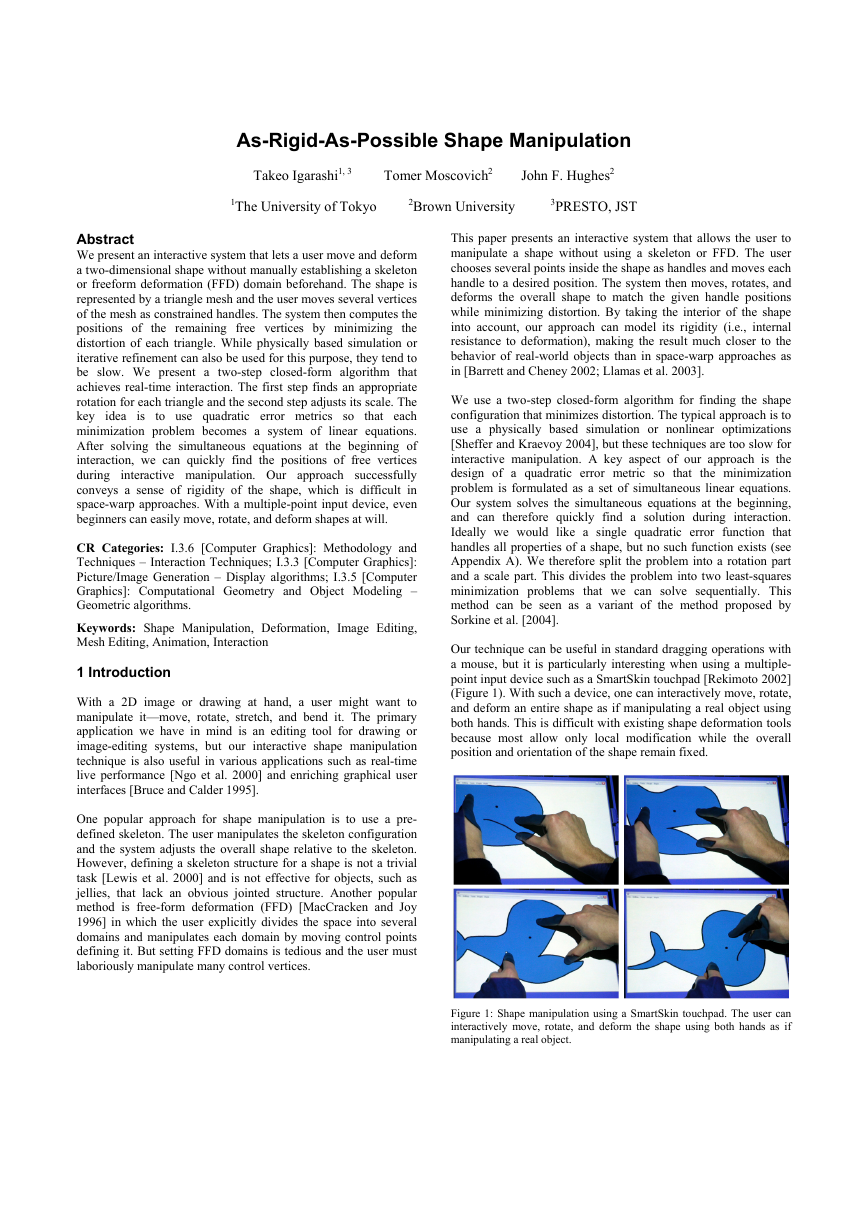
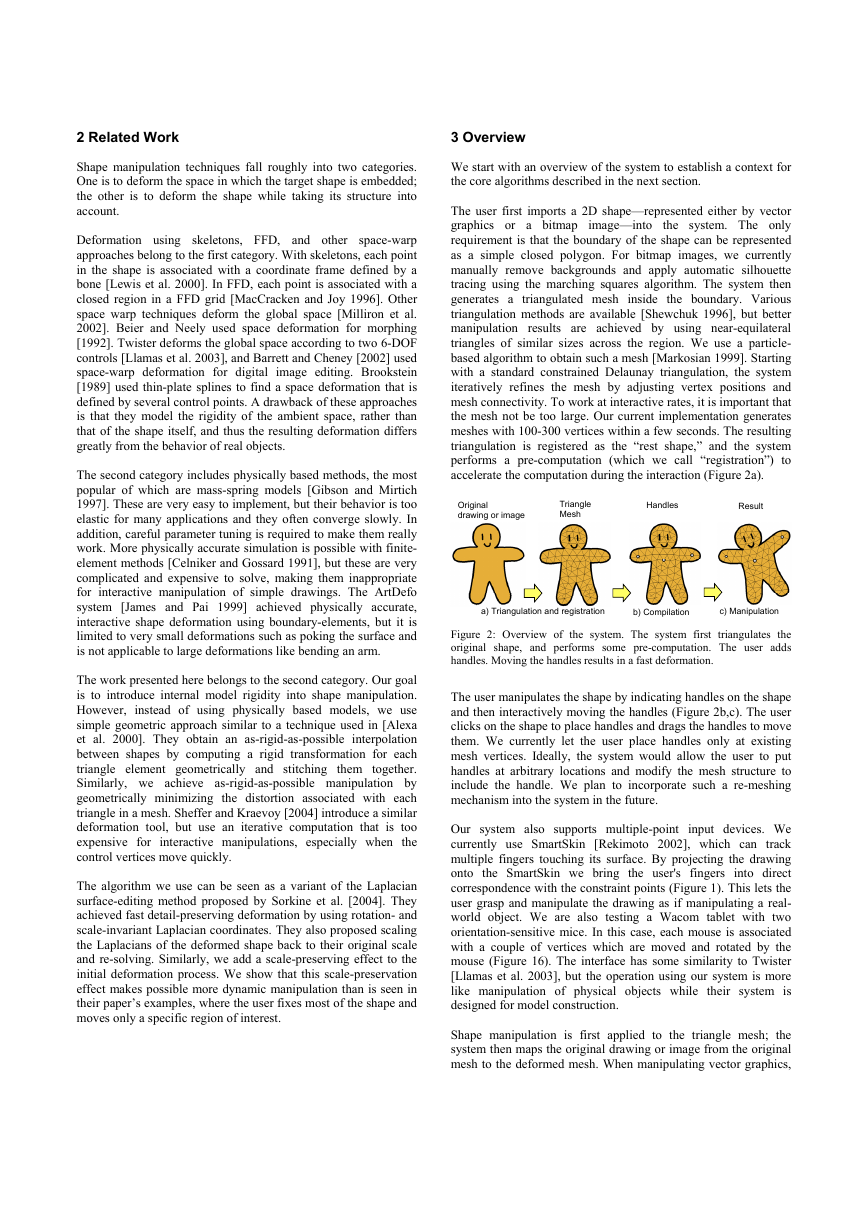
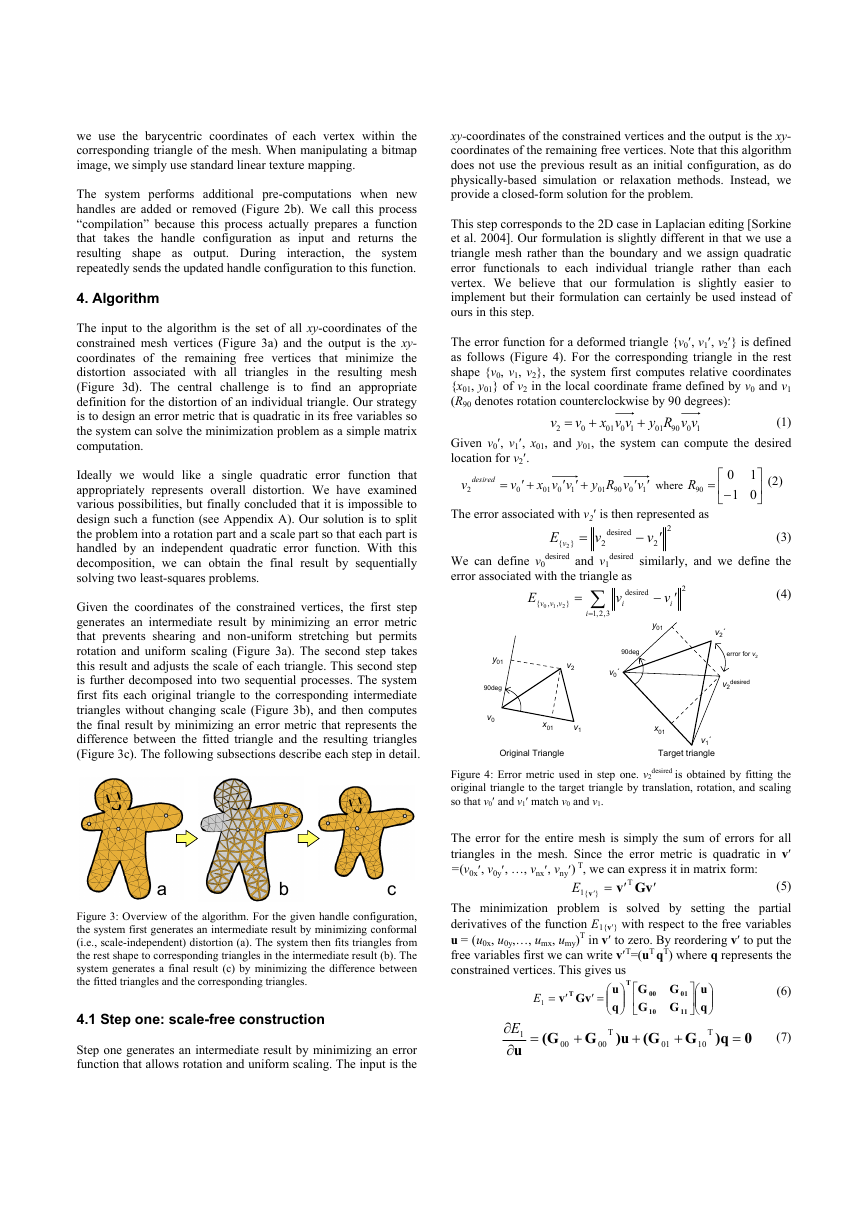
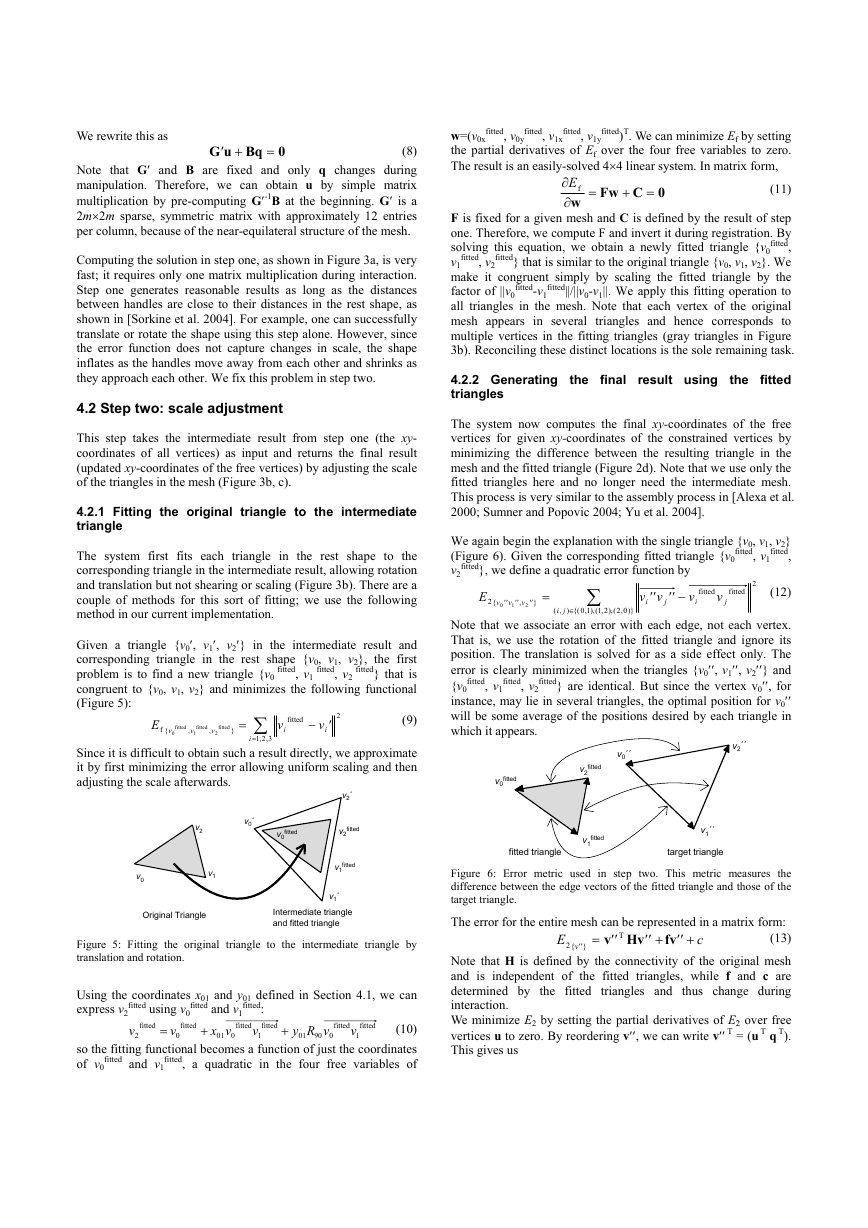
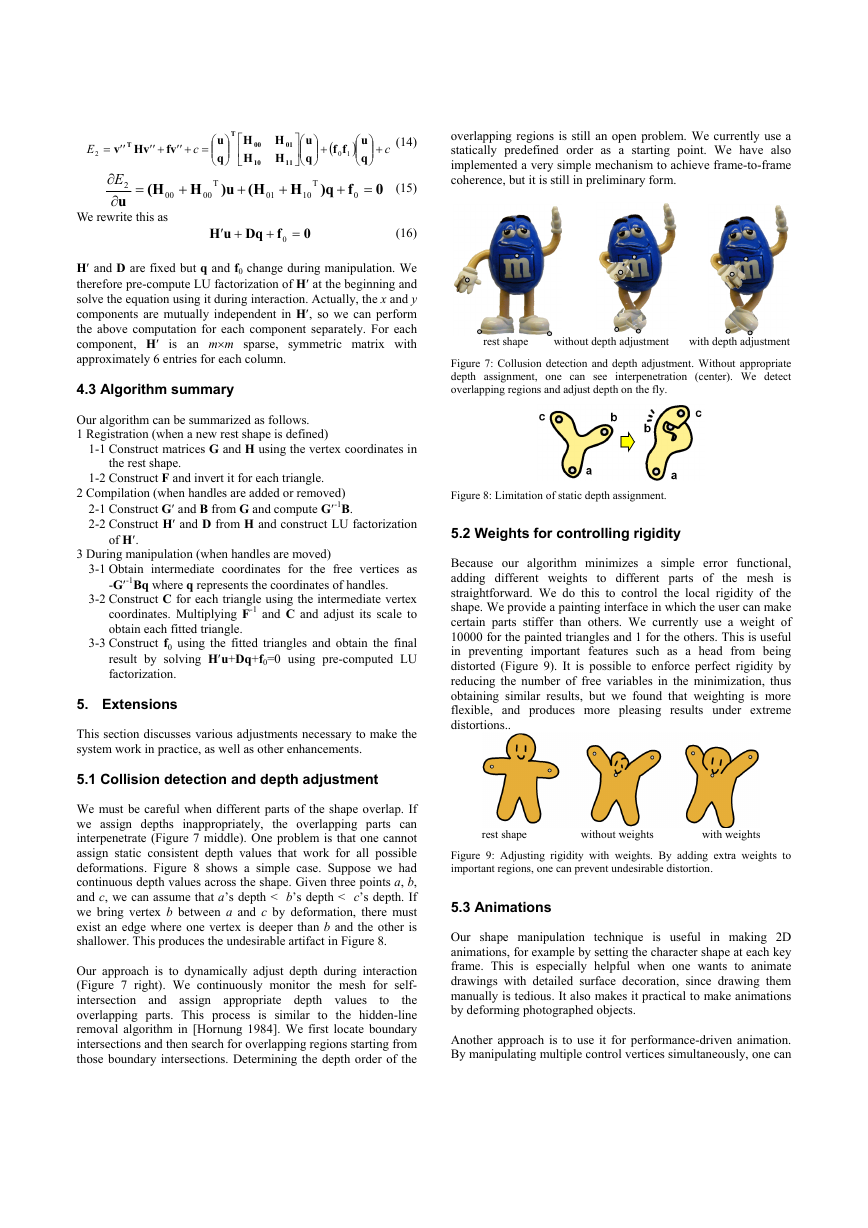
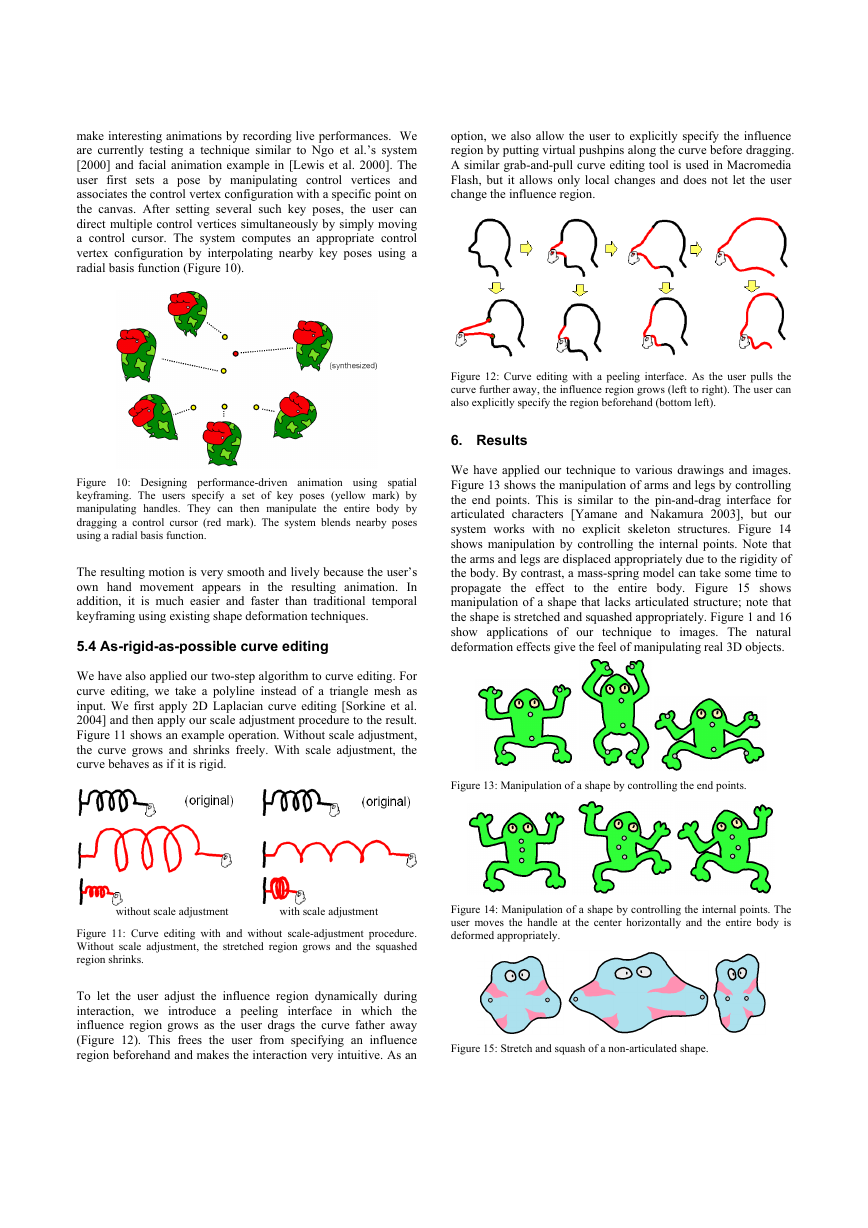
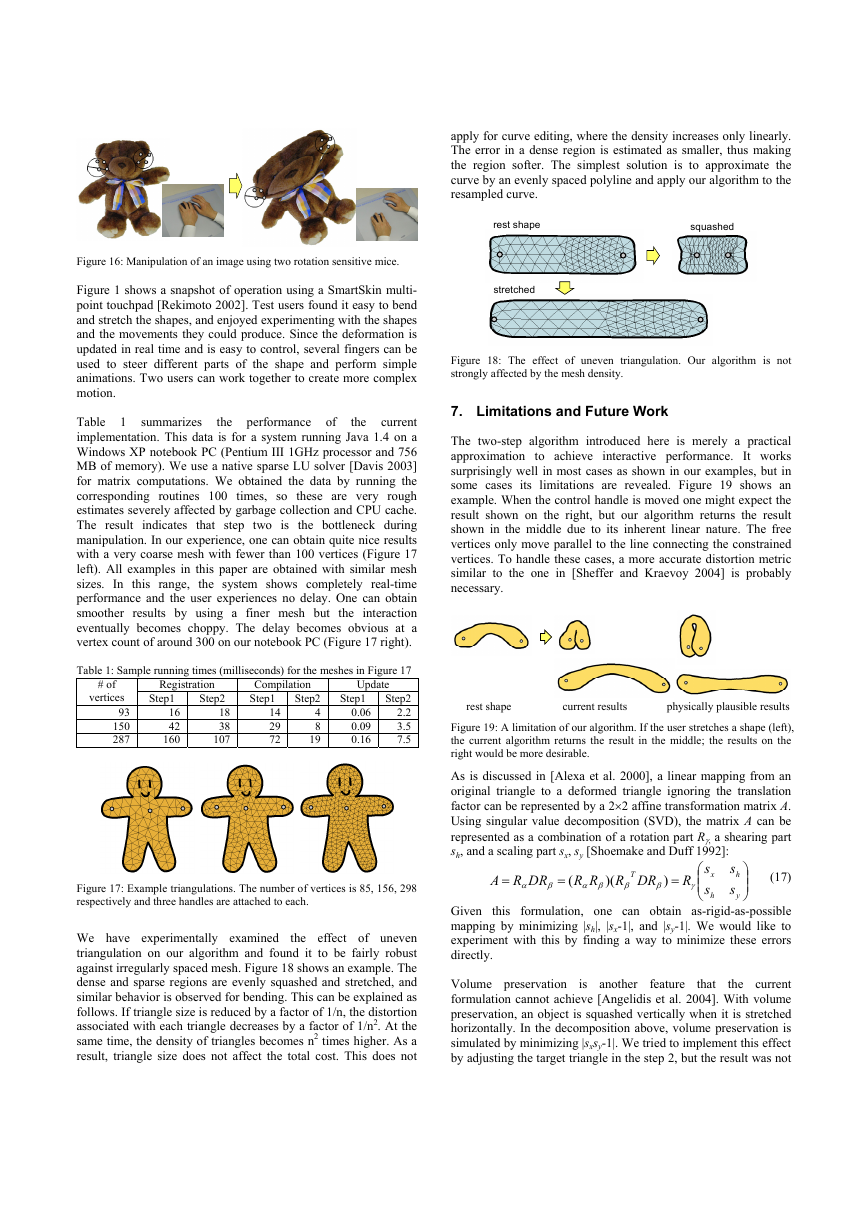
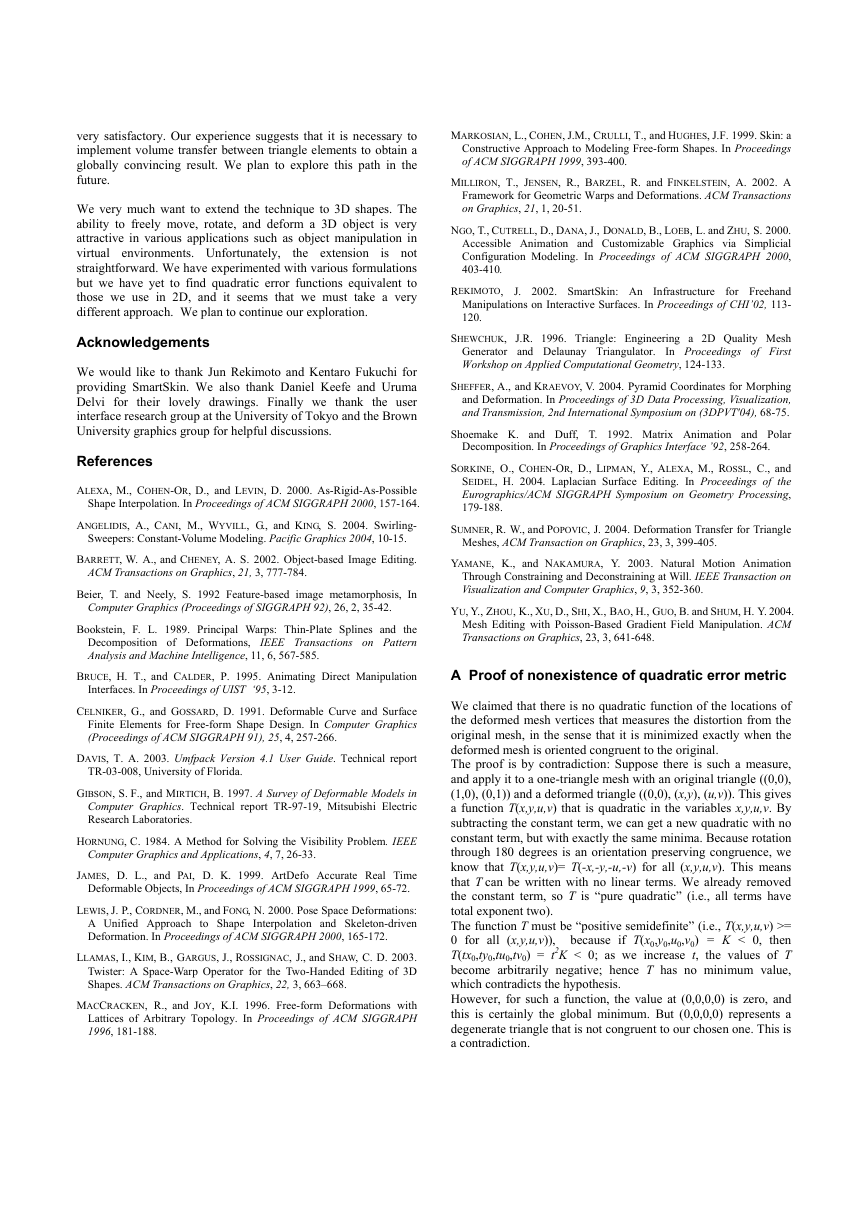








 2023年江西萍乡中考道德与法治真题及答案.doc
2023年江西萍乡中考道德与法治真题及答案.doc 2012年重庆南川中考生物真题及答案.doc
2012年重庆南川中考生物真题及答案.doc 2013年江西师范大学地理学综合及文艺理论基础考研真题.doc
2013年江西师范大学地理学综合及文艺理论基础考研真题.doc 2020年四川甘孜小升初语文真题及答案I卷.doc
2020年四川甘孜小升初语文真题及答案I卷.doc 2020年注册岩土工程师专业基础考试真题及答案.doc
2020年注册岩土工程师专业基础考试真题及答案.doc 2023-2024学年福建省厦门市九年级上学期数学月考试题及答案.doc
2023-2024学年福建省厦门市九年级上学期数学月考试题及答案.doc 2021-2022学年辽宁省沈阳市大东区九年级上学期语文期末试题及答案.doc
2021-2022学年辽宁省沈阳市大东区九年级上学期语文期末试题及答案.doc 2022-2023学年北京东城区初三第一学期物理期末试卷及答案.doc
2022-2023学年北京东城区初三第一学期物理期末试卷及答案.doc 2018上半年江西教师资格初中地理学科知识与教学能力真题及答案.doc
2018上半年江西教师资格初中地理学科知识与教学能力真题及答案.doc 2012年河北国家公务员申论考试真题及答案-省级.doc
2012年河北国家公务员申论考试真题及答案-省级.doc 2020-2021学年江苏省扬州市江都区邵樊片九年级上学期数学第一次质量检测试题及答案.doc
2020-2021学年江苏省扬州市江都区邵樊片九年级上学期数学第一次质量检测试题及答案.doc 2022下半年黑龙江教师资格证中学综合素质真题及答案.doc
2022下半年黑龙江教师资格证中学综合素质真题及答案.doc